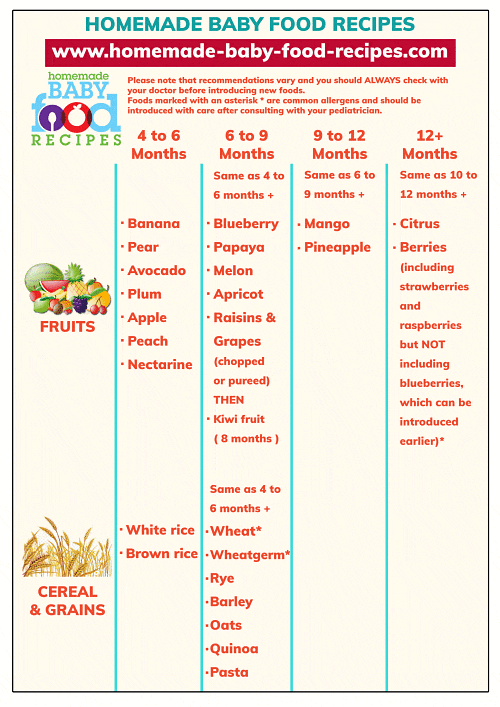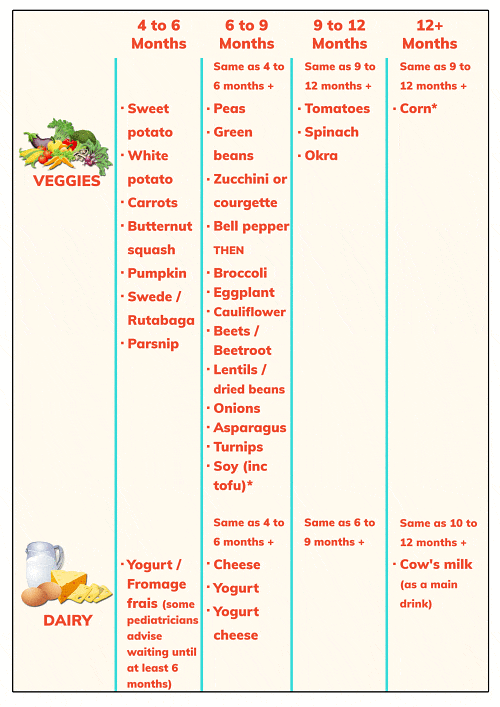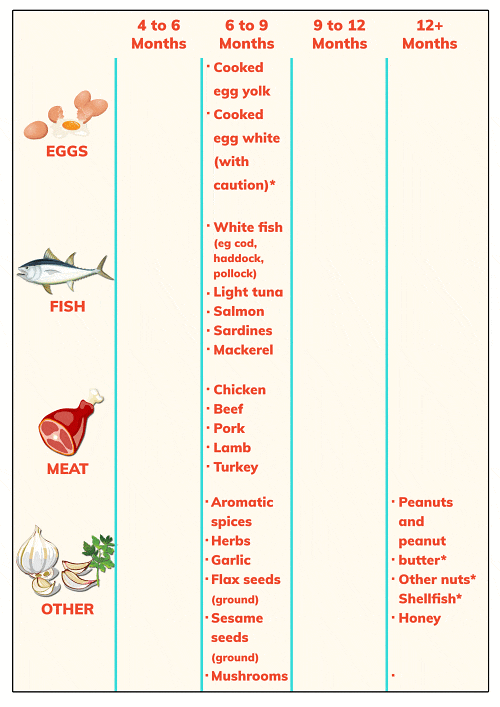Baby Food Chart For Baby’s First Year
Updated: Aug 08, 2023
This baby food chart makes it quick and easy to determine the best foods for baby at each stage.
Please note that it is important to discuss the introduction of all new foods with your pediatrician, as he or she will be acquainted with your family’s medical history and will be able to advise you if certain foods are not appropriate for your child.
Notes about our baby food chart
Guidelines issued by the AAP in 2008 stated that…
“…Although solid foods should not be introduced before 4 to 6 months of age, there is no current convincing evidence that delaying their introduction beyond this period has a significant protective effect on the development of atopic disease regardless of whether infants are fed cow milk protein formula or human milk. This includes delaying the introduction of foods that are considered to be highly allergic, such as fish, eggs, and foods containing peanut protein.”
This meant that a much wider range of foods could be introduced at 6 months than previously recommended.
Further research and publications suggest that delaying highly allergic foods – such as wheat and eggs – might even INCREASE the risk of food allergy.
Despite this, some foods on our chart are marked as being appropriate for babies of 8 months or even later!
This is because these tend to be foods that some parents find cause digestive issues such as gas (or wind), or may be a little too acidic for younger babies.
In order to keep this baby food chart easy to read, we haven’t added too many details…
…but you can easily learn more about each food listed by visiting our navigation menu (at the top of the page on desktop, or the blue button on mobile).
Just click on fruits/vegetables/meat etc and you’ll find the answers to all your questions, along with lots of yummy recipes!
NOTE: Since this chart was produced, the guidelines for introducing peanuts have been amended.
Please see this page for more information
This chart is printable
Here’s a list of other articles from our site to support you in your homemade baby food adventure!
If you still have questions to which you can’t find the answers, then please contact us – we’re happy to help and respond personally to all inquiries as quickly as we can!
A complete guide for baby food beginners, including extra information for breastfeeding moms, parents of preemies and those dealing with infant reflux.
This section offers tips about exactly HOW to get started with baby’s first foods, with advice for the best type of spoon to use, the best time of day to get started and the best type of food to offer for that very first taste of solids!
Feeding Your 6 to 9 Month Baby
This section looks at the different food groups your baby can enjoy at this stage, with links to pages offering recipes and in-depth information for a wide range of nutritious ingredients.
You’ll also find advice about introducing texture, offering a sippy cup and more!
Feeding Your 10 to 12 Month Baby
10 months seems to be around the time when some babies tend to become a little picky about what they eat and may start to refuse foods they’ve previously enjoyed.
In addition to a range of age-appropriate baby food recipes, this section offers advice about how to deal with common baby feeding problems.
If you’ve decided to pass on the purees, here’s your guide to allowing baby to feed himself.
This section aims to answer all your baby led weaning questions and includes links to pages with simple but tasty baby led weaning recipes
This part of our site looks at how and when to introduce finger foods to your baby.
You’ll find links to lots of finger food recipe suggestions using the ingredients that appear on the baby food chart, helping you provide a varied menu for your little self-feeder.
Does your baby gag when you feed him? Does he refuse to eat anything lumpy? Find out WHY this happens and how and when to adjust the texture of your baby’s food.
Constipation is a common problem when solids are introduced – here are some natural remedies and a guide to which foods on the baby food chart can help… and which ones may make the problem worse.
Feeding a baby who’s just suffered a bout of diarrhea can be nerve wracking. This page suggests which foods from the baby food chart are the most helpful in preventing any further problems.
Our main baby food allergy page, helping you prevent and identify reactions to certain foods. This page includes links to pages offering specific allergy information for a range of ingredients.
If your child has been diagnosed with G6PD Deficiency, you may be unsure about which foods to avoid when introducing solids. This page lists the main ‘triggers’ of the condition and provides links to helpful resources.
Baby Food Preparation and Storage
Everything you need to know about preparing and storing homemade food for your baby, from how to safely refrigerate or freeze your creations to the best types of baby food storage containers to use.
Complete List of Baby Food Articles
Browse a comprehensive list of all the articles on our site, or use the ‘search’ box to find just what you’re looking for.





